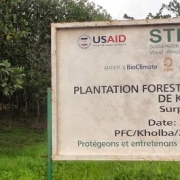Sachs says Millennium Villages are a model to avoid famine

Photo credit: Millenium Villages
Last week, renowned development economist and special advisor to the UN secretary for the millennium development goals, Jeffrey Sachs, wrote a series of public articles advocating for use of “cutting-edge technologies” to fight the current epidemic and to create sustainable solutions to avoid famine in the first place. He said that the Millennium Villages are a good example of ways to use technology in order to anticipate and prevent drought and famine from spreading.
What technologies are the Millennium Villages using? How do these technologies inform and assist villagers to mitigate potential food insecurity and the affects of climate change?
As listed on the Millennium Villages website, the main goals that for ICTs include:
- Establish and improve mobile telephone and internet connection
- Greater access to energy, improved transport and information and communication technologies (ICT)
In addition, each village has individualized goals and projects, depending on their circumstances and resources. Many of the villages have implemented mHealth initiatives, computer laboratories, other ICT-related projects. Just a few have organized ICT projects to ensure energy and environmental sustainability. Those few include:
- Dertu, Kenya – In 2008, in partnership with Ericsson, Dertu received a cell tower and Internet connectivity; Sony-donated laptops provide Internet access at the school
- Ruhiira, Uganda – Schools and clinics now have access to electricity through low-cost solar technologies
- Ruhiira, Uganda – Partnership with Zain and Ericsson has increased cell phone coverage through the construction of cell towers
Perhaps additional ICT-based projects are underway to ensure environmental sustainability and avoid the long-term effects of drought, but they are not listed on the Millennium Villages website. Sachs’ claim that ICTs have decreased famine and anticipated drought in the Millennium Villages, then, is possibly true, but is not verified by documented evidence available on their website. A more detailed evaluation of the villages is needed, or a report synthesizing the lessons learned from the ICT projects completed.
As many have pointed out over the past few months during the famine and drought in the horn of Africa, famine is preventable when the circulation of goods is active and well-planned. Stable distribution of goods, and monitoring of climate change and weather patterns is key to ensuring food security, environmental sustainability, and consistent agricultural production. ICTs can aid in all of these practices, but their effectiveness is in need of additional documentation and review.






































